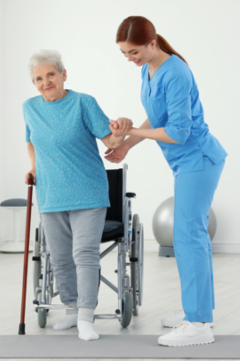 Stroke changes a person’s life forever. The aftermath can negatively affect how the body functions, including altered motor, speech and language skills. Cognitive shifts, emotional changes and vision issues could make you a completely different person. For these reasons, rehabilitation is an essential part of stroke recovery.
Stroke changes a person’s life forever. The aftermath can negatively affect how the body functions, including altered motor, speech and language skills. Cognitive shifts, emotional changes and vision issues could make you a completely different person. For these reasons, rehabilitation is an essential part of stroke recovery.
What Is Stroke?
This condition, the fourth-leading cause of death in the US, can often be traced back to a blood clot, which restricts blood flow and oxygen to the brain. If untreated, or there is a delay in treatment, cell death occurs within the brain. This process affects cognitive function, speech and motor skills.
For the two-thirds of people who survive a stroke, rehabilitation is the pathway to adaptation. While rehab won’t cure a patient, it assists survivors in relearning lost skills and helps them get around new limitations. The sooner a survivor starts treatment, the greater chance of reacquiring lost skills.
How Does Stroke Rehabilitation Work?
For some patients, rehabilitation may begin within 24 to 48 hours after their hospital stay. Typically, patients stay hospitalized up to four days for an ischemic stroke and seven days for a hemorrhagic incident. At this point, the patient may be transferred to an inpatient rehabilitation facility, a skilled nursing facility or long-term acute care hospital. In some instances, a patient may be discharged home for rehabilitation.
In terms of relearning skills and working toward independence, research has shown that patients in a focused rehabilitation setting have stronger outcomes than those who don’t receive treatment. Because the brain makes the greatest progress within the first few months after a stroke, starting rehabilitation as soon as possible helps improve outcome.
However, the condition’s complications affect a patient’s ability to recover and how long that process will take. In some cases, rehabilitation takes years or could be an ongoing process with gradual gains.
In all cases, stroke rehabilitation centers around focused tasks and repetitive practice. The skills and tasks may cover:
- Coordinating leg movements – the first step to walking and performing other complex tasks.
- Learning how to bathe and dress independently.
- Communicating effectively with limited language skills.
Over time, a survivor will hopefully start to regain some of these skills and the rehabilitation plan can be adjusted to your current abilities. However, changes are not immediate. Most patients start to notice a difference after one year of rehabilitation sessions.
Mobility and Motor Skills
Rehabilitation typically begins with motor skill-based exercises and mobility training. Based on recommendations from the American Heart Association/American Stroke Association, intense mobility task training is tailored to climbing stairs, balance, speech and eye movement, and frequently includes a personalized component geared toward an individual’s abilities. In turn, your program may begin with:
- Exercises geared toward improving muscle strength and coordination
- Exercises to help you relearn or gain confidence in swallowing
- Learning how to use a mobility aid
- Relearning how to walk, including with an ankle brace for improving strength and stability
- Constraint-induced or forced-use therapy, in which the more-mobile limb is restrained as you work on strengthening and improving functioning in the affected limb
- Range-of-motion therapy focuses on easing muscle tension and improving the affected limb’s range of motion
While exercises may initially involve a mix of passive and active tasks, mobility and motor skill therapy gradually shifts to dressing, bathing and using a toilet. In the process, patients are tasked with engaging their affected limbs through these routines.
Cognitive
Survivors frequently experience memory loss and difficulty with processing, problem solving and social skills. Therapy for speech and communication issues or psychological treatment may help a patient:
- Relearn how to speak and write
- Improve listening and comprehension skills
- Connect with other stroke survivors
- Be in touch with and talk about emotions
Modifying the Home
A newer component of rehabilitation, a facility or therapist may work with the patient’s caregiver to reduce fall hazards in the home. Homes may be modified so that navigating with a cane, wheelchair or walker is more manageable for the patient.
West Hartford Health & Rehabilitation Center offers both short-term and long-term care for stroke survivors. To learn more about how we can help your loved one, give us a call today.

